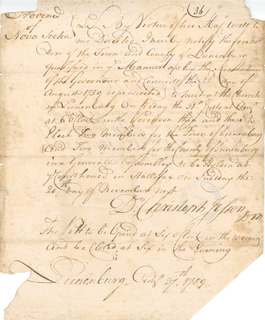
The Senate is the upper house of the bicameral Parliament of Australia, the lower house being the House of Representatives. The composition and powers of the Senate are established in Chapter I of the Constitution of Australia. There are a total of 76 senators: 12 are elected from each of the six Australian states regardless of population and 2 from each of the two autonomous internal Australian territories. Senators are popularly elected under the single transferable vote system of proportional representation.
The Australian electoral system comprises the laws and processes used for the election of members of the Australian Parliament and is governed primarily by the Commonwealth Electoral Act 1918. The system presently has a number of distinctive features including compulsory enrolment; compulsory voting; majority-preferential instant-runoff voting in single-member seats to elect the lower house, the House of Representatives; and the use of the single transferable vote proportional representation system to elect the upper house, the Senate.
In the Parliament of Australia, a casual vacancy arises when a member of either the Senate or the House of Representatives:

Senate of Pakistan or Aiwān-e-Bālā Pākistān, is the upper legislative chamber of the bicameral legislature of Pakistan, and together with the National Assembly makes up the Parliament of Pakistan.

A writ of election is a writ issued ordering the holding of an election. In Commonwealth countries writs are the usual mechanism by which general elections are called and are issued by the head of state or their representative. In the United States, it is more commonly used to call a special election for a political office.
Elections in Australia take place periodically to elect the legislature of the Commonwealth of Australia, as well as for each Australian state and territory and for local government councils. Elections in all jurisdictions follow similar principles, although there are minor variations between them. The elections for the Australian Parliament are held under the federal electoral system, which is uniform throughout the country, and the elections for state and territory Parliaments are held under the electoral system of each state and territory.
A fixed-term election is an election that occurs on a set date, and cannot be changed by incumbent politicians other than through exceptional mechanisms if at all.
A double dissolution is a procedure permitted under the Australian Constitution to resolve deadlocks in the bicameral Parliament of Australia between the House of Representatives and the Senate. A double dissolution is the only circumstance in which the entire Senate can be dissolved.
The Australian referendum of 12 December 1906 approved an amendment to the Australian constitution related to the terms of office of federal senators. Technically it was a vote on the Constitution Alteration Bill 1906, which after being approved in the referendum received the royal assent on 3 April 1907. The amendment moved the date of the beginning of the term of members of the Senate from 1 January to 1 July so that elections to the federal House of Representatives and the Senate could occur simultaneously.
The Constitution Alteration Bill 1977, was an unsuccessful proposal to alter the Australian Constitution to enable simultaneous elections for the House of Representatives and the Senate. It was put to voters for approval in a referendum held on 21 May 1977.
The Constitution Alteration Bill 1977, was a successful proposal to alter the Australian Constitution concerning the filling of casual vacancies in the Senate. It was put to voters for approval in a referendum held on 21 May 1977. After being approved in the referendum, it received the royal assent and became law on 29 July 1977.
The Senate was the upper house of the Parliament of South Africa between 1910 and its abolition from 1 January 1981, and between 1994 and 1997.

The 1910 Australian federal election was held in Australia on 13 April 1910. All 75 seats in the House of Representatives, and 18 of the 36 seats in the Senate were up for election. The incumbent Commonwealth Liberal Party led by Prime Minister Alfred Deakin was defeated by the opposition Labour Party, led by Andrew Fisher.
Section 13 of the Constitution of Australia provides for three aspects of the terms of members of the Australian Senate: the timing of elections, the commencement date of their terms and for the Senate to allocate long (six-year) and short (three-year) terms following a double dissolution of the Parliament of Australia. While members of the House of Representatives and territory senators have a maximum three-year term, state senators have a fixed six-year term, subject only to the parliament being dissolved by a double dissolution.

Section 24 of the Constitution of Australia is titled "Constitution of House of Representatives". It provides that the House of Representatives be "directly chosen by the people of the Commonwealth" and have twice as many seats as the Senate. It also provides a formula for the number of seats in each state, subject to later amendment by the parliament, and guarantees at least five members for each original state.
Section 57 of the Constitution of Australia concerns how deadlocks between the two houses of the Commonwealth Parliament—the House of Representatives and the Senate—should be resolved. If the House of Representatives passes a bill that the Senate rejects, fails to pass, or proposes amendments that the House of Representatives will not agree to, and this repeats itself three months later with regards to the same bill, then the Governor-General can call a double dissolution of the Parliament, so long as the House of Representatives is not six months or less from its expiration.

Western Australia v Commonwealth, also known as the First Territory Senators' Case, was an important decision of the High Court of Australia concerning the procedure in section 57 of the Constitution and the representation of territories in the Senate. The Court unanimously held that legislation providing for the representation of the Northern Territory and the Australia Capital Territory in the Senate had been passed in accordance with section 57 of the Constitution and, by majority, that the representation of the territories was constitutionally valid.
The 1988 Constitution Alteration , was an unsuccessful proposal put to referendum in the 1988 Australian referendum on 3 September 1988. It proposed to alter the Australian constitution so that both the House of Representatives and the Senate would be elected for a term of four years. This involved reducing the terms of the Senate from six years to four years, and increasing the terms of the House of Representatives from three years to four years. It also proposed for the fourth time that Senate and House elections occur simultaneously.
The Constitution Alteration Bill 1988, was an unsuccessful proposal to alter the Australian Constitution to enshrine the principle that each elector's vote should have equal value in Australia, also referred to as one vote, one value, including in states and territories. It was put to voters for approval in a referendum held on 3 September 1988.

The next Australian federal election will be held some time in or before 2025 to elect members of the 48th Parliament of Australia. All 151 seats in the House of Representatives and likely 40 of the 76 seats in the Senate will be contested. It is expected that at this election, the Labor government of Prime Minister Anthony Albanese will be seeking re-election to a second term in office, opposed by the Liberal/National Coalition under Leader of the Opposition Peter Dutton.




